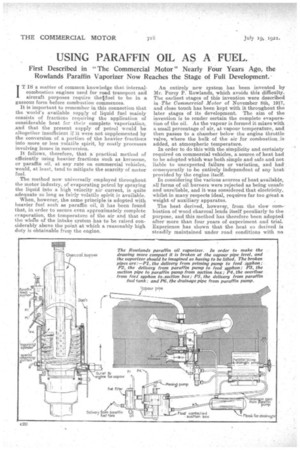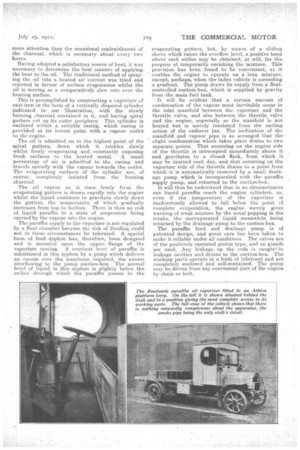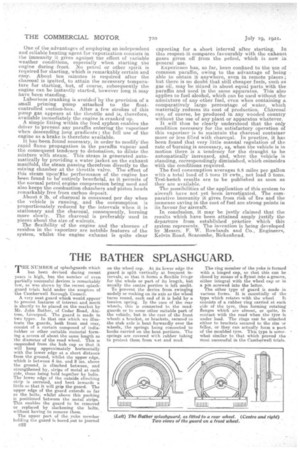• USING PARAFFIN OIL AS A FUEL.
Page 16

Page 17

Page 18

If you've noticed an error in this article please click here to report it so we can fix it.
First Described in "The Commercial Motor" Nearly Fur Years Ago, the Rowlands Paraffin Vaporizer Now Reaches the Stage of Full Development.
IT IS a matter of common knowledge that internalcombustion engines used for road transport and aircraft purposes require thetfuel to be in a gaseous form. before combustion commences.
It is important to remember in this connection that the. world's available_ supply of liquid fuel mainly consists of fractions requiring the application of considerable heat for their complete vaporization; and that the present supply of petrol would be altogether insufficient if it were not supplemented by the conversion of a portion of the heavier fractions into more or less volatile spirit, by costly processes involving losses in conversion.
It follows, therefore, that a practical method of efficiently using heavier fractions Such as kerosene, or paraffin oil, at any rate on commercial vehicles, would, at least, tend to mitigate the scarcity of motor fuel. •
' The method now universally employed throughout the motor industry, of evaporating petrol by spraying the liquid into a high velocity air current, is quite adequate so long as fairly volatile spirit is available. When, however, the same principle is adopted with heavier fuel such as paraffin oil, it has been found that, in order to secure even approximately complete evaporation, the temperature of the air and that of the whole of the intake system has to be raised considerably above the point at which a reasonably high duty is obtainable from the engine. An ,entirely new system has been invented by Mr. Percy P. Rowlands, which avoids this difficulty. The earliest stages of this invention were described in The Commercial Motor of November 8th, 1917, and dose touch has been. kept with it throughout the later stages of its development. The aim of the invention is to render certain the complete evaporation of the oil. As the vapour is formed it mixes with
small percentage of air, at vapour temperature, and then passes to a chamber below the engine throttle valve, where the bulk of the air for combustion is added, at atmospheric temperature.
In order to do this with the simplicity and certainty required on commercial vehicles, a source of heat had to be adopted which was both. simple and safe and not liable to unexpected failure or variation, and had consequently to he entirely independent of any heat provided by the engine itself,
In considering the various sources of heat available, all forms of oil burners were rejected as being unsafe and unreliable, and it was considered that electricity, whilst in many respects ideal, requires far too great a weight of auxiliary apparatus.
The heat derived, however, from the slow combustion of wood charcoal lends itself peculiarly to the purpose, and this method has therefore been adopted after more than four years of experiment and trial. Experience has shown that the heat so derived is steadily maintained under road conditions with no more attention than the oecisiotial replenishment of the charcoal, which is necessary about every two hours.
Having adopted a. satisfactory source of heat, it was necessary to determine the best --manner of applying the heat to the oil. The traditional method of spraying the oil into a heated air current was tried and rejected in favour of surface evaporation whilst the oil is moving at a comparatively slow rate over the heating surface.
This is accomplished by constructing a vaporizer of east-iron in the form of a vertically disposed -cylinder indicated inr our illustration, with, the slowly burning charcoal contained in it, and having spiral gutters cut on its outer periphery. This cylinder is enclosed within a suitable easing, which casing is provided at its lowest. point with a vapour outlet to the engine.
The .oil is admitted on to the highest point of the spiral gutters, down which it trickles slowly whilst freely evaporating and .constantly exposing fresh surfaces to the heated metal. A small percentage of air . is admitted to the casing and travels spirally with the vapour towards the outlet. The evaporating surfaces of the cylinder are, of course, completely isolated from the burning chareoal.
The oil vapour as it rises freely from the evaporating gutters is drawn rapidly into the engine whilst the liquid continues to gravitate slowly down the gutters, the temperature of which gradually increases from top to bottom. There is thus no risk of. liquid paraffin in a state of suspension being carried by the vapour into the engine.
The paraffin supply to the vaporizer is not regulated by a float chamber because the risk .of flooding could not in these circumstances 'be tolerated. A special form of feed syphon has, therefore, been designed and is mounted upon the uppea flange of the.
vaporizer casting. A constant level of paraffin is maintained in this syphon by a pump which delivers an excess over the maximum 'required, the excess overflowing to the pump auction-box. The normal level of liquid in this syphon is slightly below the orifice through which the paraffin passes to the
evaporating gutters, but, by means of a sliding ele,eve whieh raises the overflow level, a positive -head above such orifice may be obtained, at will, for the, purpose of temporarily enriching the Mixture.. This pro-vision has been found to be convenient, as it enables the engine to operate on a lean mixture, except, perhaps, when the laden vehicle is ascending a gradient. .The pump draws its supply from a floatcontrolled suction-box, Which is supplied by gravity from the main fuel tank.
It will be evident that a certain amount of condensation of the vapour must inevitably occur in the inlet manifold between the vaporizer and the throttle valve, and also between the throttle valve and the engine, especially as the manifold is not heated but is merely insulated from tilt pooling action of the radiator fan. The inclination of the manifold and vapour pipe is so arranged that thee slight condensation which takes place drains to two separate points. That occurring on the engine sideof the throttle is intercepted immediately above itand gravitates to a closed flask, from which it may be drained each day, and that occurring on the vaporizer side of the throttle drains to a point from which it is automatically removed by a small drainage pump which is incorporated with the paraffin supply pump,, and returned to the suction-box.
It will thus be understood that in no circumstances can liquid paraffin reach the engine cylinders, as, even if the temperature Of the vaporizer is inadvertently allowed to fall below the point of complete evaporation, • the engine merely -gives warning of weak mixture by the usual popping in the intake, the unevaporated liquid meanwhile being • returned by the drainage pump to the suction-box. The paraffin feed and drainage pump is of patented design, and great care has been taken to make it reliable under all conditions. The valves are of the positively operated piston type, and no glands are used. . Any leakage up the rods is caught in leakage cavities and drains to the suction-box. The working parts operate in a bath of lubricant and are completely enclosed and self-contained. Ile pinup may be. driven from any convenient part of the engine by chain or belt. One of the advantages of employing an independent and reliable heating agent for vaporization consists in the immunity it gives against the effect of variable weather conditions, especially when starting the engine during •frost. No petrol or other spirit is required for starting, which is remarkably certain and easy. About ten minutes is required after the charcoal is ignited, to attain the necessary temperature for starting, but, of course, subsequently the engine can be instantly started, however long it may have been standing.
Laborious cranking is avoided-by the provision of a small priming pump attached to the floatcontrolled snctionebox. After a few strokes of this pump gas appears at the throttle and is, therefore, available immediately the engine is cranked up.
A simple fitting within the feed syphon enables the driver to prevent any paraffin entering the vaporizer when descending long gradients ; the full use of the engine as a brake is therefore available.
It has been found necessary, in order to modify the rapid flame propagation in the paraffin vapour and the consequent tendency to detonation, to dilute the mixture with steam. This steam is generated automatically by providing a water jacket on the exhaust manifold, the steam passing therefrom directly to the mixing chamber at the throttle valve. The effect of this steam upore,the performance of the engine has been found to be -entirely beneficial, as it permits of the normal petrol engine compression being used and also.keeps the combustion chambers and piston heads remarkably free from carbon deposit. . About 8 lb. of charcoal is consumed per day when the vehicle is running, and the consumption is proportionately reduced by the intervals when it is stationary and the charcoal, consequently, burning more slowly. The charcoal is preferably used in pieces about the size of walnuts.
The flexibility of the engine and the-absence of residue in the vaporizer are notable features of the system, whilst the engine exhaust is quite clear expecting for a short interval after starting. In this respecteit compares favourably with the exhaust gases given off from the petrol, which is now in general .use.
Experience has, so far, been confined to the use of common paraffin, owing to the advantage of being able to obtain it anywhere, even in remote places ; but there is no doubt that still cheaper fuels, such as gas oil, may be Mixed in about equal parts with the paraffin and used in the same apparatus. This also applies to fuel alcohol, which can be used without the admixture of any other fuel, even when containing a comparatively large percentage of water, which naterially reduces its cost of production. Ch'arcoal. can, of course, be produced in any wooded country without the use of any plant or apparatus whatever.
It will thus be clearly understood that the only condition necessary for the satisfactory operation of his vaporizer is to maintain the charcoal container niore at less filled with charcr2al. In practice, it has been found that very little manual regulation of the ate of burning is necessary, as, when the vehicle is in niotion there is a tendency for the (-fraught to be S increased, and., when the vehicle is tanding, correspondingly diminished, which coincides vvith the conditions required.
The fuel consumption averages 8.8 miles per gallon rvith a total load of 5 tons 19 cwts., net load 3 tons, Test-bench results are to be published as soon as hey are available.
The possibilities of the application of this system to aircraft have not yet been investigated. The comparative immunity it gives, from risk of 'fire and the mmense saving in the cost of fuel are strong points in ts favour for aircraft.
In conclusion, it may be justly claimed that the esults -which have been attained amply justify the eparture from established .practice which this ystem represents.. The invention is being developed y Messrs: F. 'W. Rowlands and Oo., Engineers,
Celvin Road, Seacombe, Birkenhead.
































